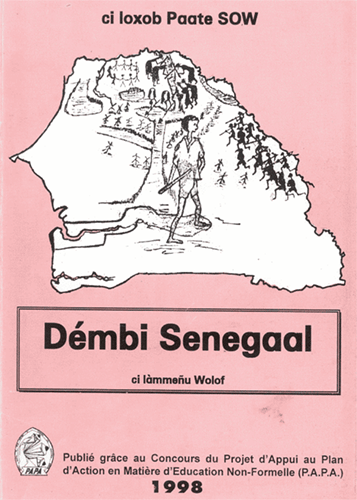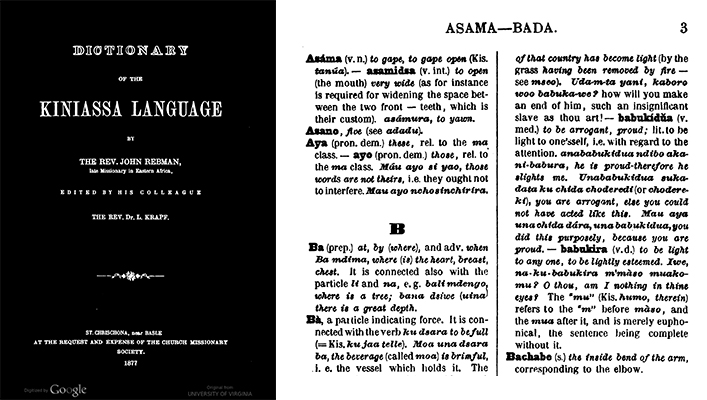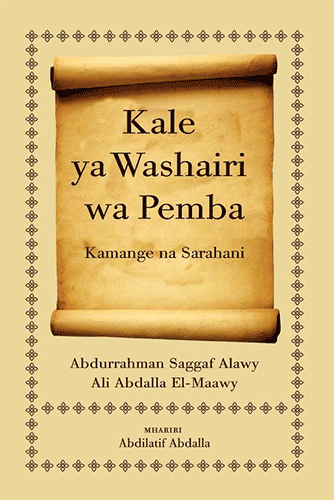Tag: BL Niger-Congo
Chichewa
The Languages of Berkeley: An Online Exhibition
“My study of the Kiniassa was to me such a continual intellectual feast, that days and weeks fled so quickly as I never remembered they had done before, and it was with great reluctance that I tore myself from it when we had to get ready for our voyage to Aden.”
— Reverend John Rebman
With over 2,000 vernacular languages, sub-Saharan Africa includes approximately one-third of the world’s languages.[1] Many of these will likely disappear in the next hundred years, displaced by dominant regional languages like Chichewa. Also known as Chinyanja or Kiniassa, Chichewa is spoken in west-central and southwest Africa. In total, the language claims nearly 10 million speakers across the region. It is an official language — along with English — in Malawi and is officially recognized in Zambia and Mozambique where it is known as Nyanja. Chichewa is part of the Bantu branch of the larger Niger-Congo phylum. Linguistics and archaeologists suggest that these languages began in the grasslands of northwestern Cameroon and north-eastern Nigeria over two thousand years ago and spread across central and southern Africa through a combination of migration and conquest.[2]
The Dictionary of the Kiniassa Language, compiled by the reverend Johannes Rebmann brom 1853-54 and posthumously published in 1877, was the first extensive written record of the Chichewa language. It is representative of the fairly prolific publishing output of European missionaries — principally religious (bible translations, hymn books, etc.) or grammar and vocabulary texts — during the early colonial period.
These types of texts — especially the grammar and vocabulary texts — can offer a unique vantage point from which to view the imaginative nature of work that is otherwise often viewed as static. For example, in works of comparative religion, scholars can use these creative texts to gain insight into how missionaries grappled with words to accurately define religious concepts such as “sin” to serve their proselytizing purposes. Ultimately, old words were re-defined or altogether new words were crafted to meet the present need.
Contribution by Adam Clemons
Librarian for African and African American Studies, Doe Library
Sources consulted:
- Moseley, Christopher, and Alexandre Nicolas. Atlas of the World’s Languages in Danger. Paris: UNESCO, 2010.
- Dalby, Andrew. Dictionary of Languages: The Definitive Reference to More Than 400 Languages. New York: Columbia University Press, 1998.
~~~~~~~~~~
Title: Dictionary of the Kiniassa Language
Author: Rebman, John, 1820-1876.
Imprint: St. Chrischona: Church Missionary Society, 1877.
Edition: 1st
Language: Chichewa
Language Family: Niger-Congo
Source: HathiTrust Digital Library (University of Virginia)
URL: https://hdl.handle.net/2027/uva.x000079094
Select print editions at Berkeley:
- Dictionary of the Kiniassa language, by the Rev. John Rebman, edited by his colleague, the Rev. Dr. L. Krapf. St. Chrischona, near Basle, Switzerland, The Church missionary society, 1877.
The Languages of Berkeley is a dynamic online sequential exhibition celebrating the diversity of languages that have advanced research, teaching and learning at the University of California, Berkeley. It is made possible with support from the UC Berkeley Library and is co-sponsored by the Berkeley Language Center (BLC).
Follow The Languages of Berkeley!
Subscribe by email
Contact/Feedback
ucblib.link/languages
Wolof
The Languages of Berkeley: An Online Exhibition

Wolof is the most widely spoken African language in Senegal, predominantly in urban areas. It is also spoken in the West African nations of Mauritania and The Gambia. Within Senegal, approximately 40% of the total population (just over 15 million according to World Bank estimates) are native speakers while the majority of the rest speak it as a second language. In Mauritania, Wolof is spoken by approximately 7% of the total population (estimated at just over 4 million by the World Bank), though the majority of speakers reside in the southernmost part of the country nearest the border with Senegal. About 3% of the total population of The Gambia (estimated at just over 2 million according to the World Bank) speak Wolof but it tends to be disproportionately influential in the country because of its prevalence in Banjul, Gambia’s largest city. Wolof is part of the Senegambia branch of the of the Niger-Congo language family, of which there are some 1,500 other languages.
Démbi Senegaal: ci làmmeñu Wolof is an account of the history of Senegal from antiquity through the end of the 19th century. By retracing these historical events, Paate Sow’s intent is to inform Wolof readers about the unique histories — political, economic, social — of the kingdoms (Jolof, Kajor, Waalao, etc.) that makeup what is today known as Senegal. Though not as culturally significant in the same way as say, Mariama Bâ’s Une si longue lettre, Paate Sow’s Démbi Senegaal: ci làmmeñu Wolof is a rare example of a title published in Wolof and available electronically. Finding titles that met this criteria — published in Wolof while also electronically available — was exceedingly difficult for all African languages represented in this exhibit. Thanks to projects like Céytu, which aims to publish — both in print and electronic form — the major works of literature from the Francophone world in Wolof, finding electronic versions of important works in African languages should be easier.
Wolof was offered for nearly a quarter century to students who could take elementary to advanced-level Wolof under the direction of instructor Alassane Paap Sow. He taught Wolof at UCB for over 20 years, and also developed material in Wolof through the BLC’s Library of Foreign Language Film Clips (LFLFC), a tagged, structured collection of clips from films and searchable database. Additionally, the Center for African Studies pioneered distance learning in the UC system by offering courses in Wolof (as well as Swahili). Wolof has not been offered at UC Berkeley since 2015 due to lack of funding.
Contribution by Adam Clemons
Librarian for African and African American Studies, Doe Library
Title: Démbi Senegaal: ci làmmeñu Wolof
Title in English: n/a
Author: Paate Sow
Imprint: Dakar : Info-edit, 1998.
Edition: 1st edition
Language: Wolof
Language Family: Niger-Congo
Source: ALMA Project (African Language Materials Archive Project) of WARC (West African Research Center)
URL: http://www.dlir.org/docs/alma_ebooks/wolof_009.pdf
The Languages of Berkeley is a dynamic online sequential exhibition celebrating the diversity of languages that have advanced research, teaching and learning at the University of California, Berkeley. It is made possible with support from the UC Berkeley Library and is co-sponsored by the Berkeley Language Center (BLC).
Follow The Languages of Berkeley!
Subscribe by email
Contact/Feedback
ucblib.link/languages
Swahili
The Languages of Berkeley: An Online Exhibition
Swahili, a Bantu language in the Niger-Congo, is the lingua franca of the African Great Lakes region and other parts of eastern and southern Africa. According to the most recent 2015 Ethnologue estimates, there are just over 98 million speakers — 16 million first language speakers; 82 million second language speakers. It is the official language of Tanzania and one of at least two official languages in Kenya, Democratic Republic of the Congo, Rwanda, and Uganda. Swahili is also listed as an official language of the African Union. Originally, Swahili was written in Arabic script and borrows many words from the language, a result of strong regional ties to the Arab world via trade and religion.
The earliest known Swahili documents were discovered on the Indian Ocean island of Kilwa along the Swahili Coast, which consists of the coastlines and nearby islands of present day Kenya, Tanzania and northern Mozambique. The island of Pemba is also located within the Swahili Coast, which was the home of Kamange and Sarahani, the authors of the poetry found in Kale ya Wahairi wa Pemba: Kamange na Sarahani (The Past of Pemba Poets: Kamange and Sarahani). Kamange and Sarahani were contemporaries and fierce rivals during the latter-half of the 19th century until their deaths in the early 20th century. Both were well regarded along the Swahili Coast. Kamange often took up subjects like love and bravery while Sarahani chose religious topics and moral instruction. Among their influences were the culture and environment of the region. Since both were Muslim, they were also influenced by Islamic literature and the Arabic language, all of which comes out in their writings.
Recognizing the cultural significance of the collection of poetry, Abdurrahman Saggaf Alawy (author of the preface, Shukurani) and Ali Abdala El-Maawy (author, along with Alawy, of the forward, Dibaji) kept the poems safe during the turbulent period during and immediately following the 1964 revolution in Zanzibar. They safely stored the collection for more than 40 years before presenting them to Abdilatif Abdala, editor of this volume, for publication.
Swahili was first offered at UC Berkeley in 1979. Today, elementary through advanced Swahili is offered each semester by Professor David Kyeu. Over the last several years, Swahili enrollment on campus has remained steady with an average of 42 students enrolled each academic term. To support Swahili language use and practice, the Center for African Studies at UC Berkeley hosts a weekly Swahili Language table where Berkeley students as well as members of the larger community can practice and improve their language skills.
Contribution by Adam Clemons
Librarian for African and African American Studies, Doe Library
Title: Kale ya Washairi wa Pemba: Kamange na Sarahani
Title in English: The Past of Pemba Poets: Kamange and Sarahani
Author: Abdilatif Abdalla
Imprint: Oxford: African Books Collective, 2012.
Edition: 1st edition
Language: Swahili
Language Family: Niger-Congo
Source: Project Muse
URL: https://muse.jhu.edu/book/22594/
Select print editions in Library:
- Anthology of Swahili poetry = Kusanyiko la mashairi / Ali Ahmed Jahadhmy. Nairobi: Heinemann Educational Books, 1975.
- Dhifa / E. Kezilahabi. Nairobi : Vide-Muwa Publishers, 2008.
- Sauti ya dhiki / Abdilatif Abdalla. Nairobi : Oxford University Press, 1973.
- Taa ya umalenga / tungo za Ahmad Nassir ; zimehairiwa na Abdilatif Abdalla. Nairobi : Kenya Literature Bureau, 1982.
- Taaluma ya ushairi / Kitula King’ei na James Kemoli Amata. Nairobi : Acacia Stantex Publishers, 2001.
The Languages of Berkeley is a dynamic online sequential exhibition celebrating the diversity of languages that have advanced research, teaching and learning at the University of California, Berkeley. It is made possible with support from the UC Berkeley Library and is co-sponsored by the Berkeley Language Center (BLC).
Follow The Languages of Berkeley!
Subscribe by email
Contact/Feedback
ucblib.link/languages

![The Languages of Berkeley [fan]](https://update.lib.berkeley.edu/wp-content/uploads/2019/02/fan_languages-450px.jpg)
